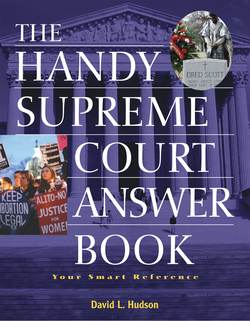Читать книгу The Handy Supreme Court Answer Book - David L Hudson - Страница 279
На сайте Литреса книга снята с продажи.
Оглавление
How many and which justices served on the Chase Court?
Thirteen justices served on the Chase Court, including Chief Justice Salmon P. Chase and Justices James Wayne, John Catron, Samuel Nelson, Robert Grier, Nathan Clifford, Noah H. Swayne, Samuel F. Miller, David Davis, Stephen Field, William Strong, Joseph Bradley, and Ward Hunt.
What government positions did Salmon Chase hold before becoming chief justice?
Salmon Chase had a distinguished career of public service. The Ohioan served in the U.S. Senate from 1849 to 1955 and then again in 1860–61. He also was Ohio’s governor from 1856 to 1860 and President Abraham Lincoln’s secretary of the Treasury from 1861 to 1864.
What views made Chase well-known before his elevation to the U.S. Supreme Court?
Chase was known for his antislavery views, believing that the “peculiar institution” was a moral abomination. Chase defended many abolitionists who had harbored fugitive slaves from the South. His defense of abolitionists earned him the moniker the “attorney general for runaway negroes.” Chase’s antislavery views caused him to join the Liberty Party and then the Free Soil Party.
How long did it take for Chase to be confirmed as chief justice?
The U.S. Senate confirmed Chase by voice vote the same day he was nominated by President Lincoln on December 6, 1864.
U.S. Supreme Court chief justice Salmon P. Chase. Hulton Archive/Getty Images.
What case did attorney Chase argue before joining the Court?
Salmon Chase argued the case of Jones v. Van Zandt (1847) before the U.S. Supreme Court on behalf of John Van Zandt, who helped slaves escape to free territory. Kentucky slaveowner Wharton Jones sued Van Zandt for harboring a 32-year-old male slave named Andrew. The Court upheld the constitutionality of the Fugitive Slave Act of 1793, rejecting Chase’s arguments that slavery was incompatible with the Bill of Rights, the Declaration of Independence, and the Northwest Ordinance of 1787, which forbade slavery in many locations, such as Chase’s home state of Ohio.
What was most unusual in Supreme Court history about the number of justices on the Chase Court?
In the early days of the Chase Court, in 1864 and 1865, there were ten justices on the Court. They were Chief Justice Chase and Justices Wayne, Catron, Nelson, Grier, Clifford, Swayne, Miller, Davis, and Field. Since 1869, when Congress passed the Judiciary Act of 1869, the maximum number of justices allowed has remained at nine.
In what decision did the Chase Court say that a person suspected of treason could not be tried by a military court?
In perhaps its most noteworthy decision, the Chase Court ruled in Ex Parte Milligan (1866) that Langdon Milligan could not be tried by a military tribunal instead of fully-functioning civil courts. Milligan and several other individuals in the Order of American Knights were arrested on charges of conspiring to steal firearms at a federal arsenal and free Confederate prisoners in Indiana. Milligan was arrested and sentenced to death by a military tribunal. Milligan petitioned a federal court for habeas corpus, asking it to rule that a military tribunal did not have the authority to try Milligan.
The Court unanimously ruled that Milligan should have been tried in a civilian, instead of military, court. In his majority opinion, Justice David Davis reasoned that civil courts were the proper forum when a defendant’s constitutional rights to trial by jury, grand jury indictment, and other protections are present. “Martial rule can never exist where the courts are open, and in the proper and unobstructed exercise of their jurisdiction,” he wrote.
Justice Salmon Chase filed a concurring opinion joined by three other justices that agreed with the result but applied different reasoning. Chase reasoned that Milligan should be released based on statutory, not constitutional, grounds. He wrote that the Habeas Corpus Act of 1863 provided that the proper forum for Milligan’s trial was a civil, not military, court. “The act of Congress of March 3d, 1863, comprises all the legislation which seems to require consideration in this connection,” Chase wrote.
